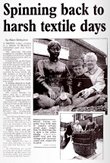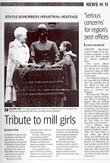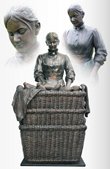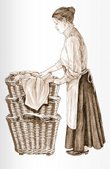Statue of Millgirl
Sited in Mossley
Mossley Mill provided employment for local people for nearly two hundred years. It began as a calico printing works and soon passed into the hands of the Grimshaw family who made it a linen spinning mill. Nicholas Grimshaw was one of the most important men in the cotton industry and when he died in 1805 his sons Edmund and Thomas took over and in addition to new buildings at Mossley, Edmund created a basin, ie pond, utilising water power to run his machinery.
"The basin situated contiguous to the building erected by the present proprietor, occupies nearly 6 acres of ground and is one of the handsomest and best situated perhaps in the above county."
Ordnance Survey Memoirs 1839
© Crown Copyright, Reproduced with permission of HMSO
Spinning is the conversion of the raw flax into linen yarn, a transformation that is time consuming and involves a range of processes. Two methods of spinning were carried out at Mossley: Gill spinning, an almost dry process that produces a strong, coarse yarn and Wet spinning, a process that produces the finer yarns. The spun yarn would be used for weaving or thread production.
Two cousins, Henry and John Campbell bought the mill in 1859. John expanded the mill and the village, and set up Mossley School in 1868 to give factory workers children a basic education. Night classes were also provided for the adult mill workers and local farmers. Throughout the 1900s, conditions gradually improvedin relation to working hours, holidays, and health and safety, with the introduction of various work related government acts and regulations.
Our Victorian mill girl is depicted sorting out bobbins in large wicker baskets that had a multitude of uses in the mill. She wears clogs, as did thousands of cotton mill workers and coal miners. Wherever it was damp or wet underfoot clogs were preferred footwear as they were cheap to buy and repair, were comfortable and did not wear out for a long time.
A young mill worker in the preparing rooms during the 1930s was paid six shillings a week (30p). At this time, one shilling would have bought about four pints of milk.








